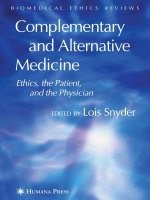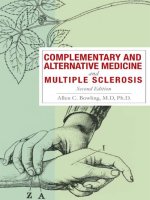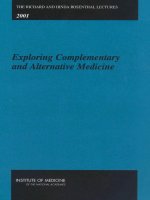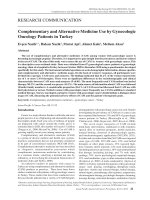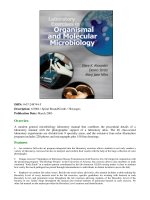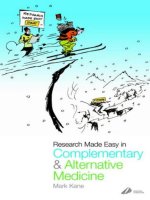Research Made Easy in Complementary and Alternative Medicine pot
Bạn đang xem bản rút gọn của tài liệu. Xem và tải ngay bản đầy đủ của tài liệu tại đây (3.3 MB, 206 trang )
CHURCHILL LIVINGSTONE
An imprint of Elsevier Limited
© 2004, Elsevier Limited. All rights reserved.
The right of Mark Kane to be identified as author of this work has been asserted by him in
accordance with the Copyright, Designs and Patents Act 1988
No part of this publication may be reproduced, stored in a retrieval system, or transmitted in
any form or by any means, electronic, mechanical, photocopying, recording or otherwise,
without either the prior permission of the publishers or a licence permitting restricted
copying in the United Kingdom issued by the Copyright Licensing Agency, 90 Tottenham
Court Road, London W1T 4LP. Permissions may be sought directly from Elsevier’s Health
Sciences Rights Department in Philadelphia, USA: phone: (+1) 215 238 7869, fax: (+1) 215
238 2239, e-mail: You may also complete your request
on-line via the Elsevier Science homepage (), by selecting ‘Customer
Support’ and then ‘Obtaining Permissions’
First published 2004
ISBN 0 443 07033 4
British Library Cataloguing in Publication Data
A catalogue record for this book is available from the British Library
Library of Congress Cataloging in Publication Data
A catalog record for this book is available from the Library of Congress
NOTICE
Complementary and alternative medicine is an ever-changing field. Standard safety
precautions must be followed, but as new research and clinical experience broaden our
knowledge, change in treatment and drug therapy may become necessary as appropriate.
Readers are advised to check the most current product information provided by the
manufacturer of each drug to be administered to verify the recommended dose, the method
and duration of administration, and contraindications. It is the responsibility of the licensed
prescriber, relying on experience and knowledge of the patient, to determine dosages and the
best treatment for each individual patient. Neither the publisher nor the author assumes any
liability for any injury and/or damage to persons or property arising from this publication.
The Publisher
Printed in China by Elsevier
The
publisher's
policy is to use
paper manufactured
from sustainable forests
vii
Foreword
As I read this book two ideas kept intruding into my concentration. The first
was that I wished I’d had this text 25 years ago when I started developing
research methodology in the field of acupuncture, and the second was the
title. Why was such a text only relevant to complementary and alternative
medicine?
Mark Kane has done a superb job, based largely on the teaching pro-
gramme at Westminster, of systematising, defining and explaining a whole
range of basic principles and concepts within the field of clinical research. He
makes it clear in his introduction that the text is not exhaustive so those
wishing to find a detailed understanding of statistical methodology will not
find it here, but there are many other texts which explain this thoroughly. This
text is targeted at undergraduates and postgraduates or those wishing to
consider a research career. It explains the process of research superbly and
defines methodologies that are entirely appropriate to the field of CAM. For
instance, case control studies are not mentioned as they would largely be
inappropriate to this field of clinical practice, however action research and
individual case studies are considered in great detail, as appropriate, and
indeed essential, techniques within CAM. In particular, the vexed question of
systematic reviews is considered very carefully. Systematic reviews of
inadequate and incompetent studies lead to either inappropriate or
inconclusive interpretation of data. Negative interpretation of inconclusive
data from systematic reviews has tended to bedevil CAM over the last 10 years
and resulted in many substantial misunderstandings, and much inappropriate
and misguided academic debate. The clarity of the chapter on systematic
reviews therefore adds substantially to the literature in this area by placing
their interpretation in context. If, as I suspect, this book will be used as
primary course material for many of those wishing to study CAM disciplines
at undergraduate level, then clarity of the issues and principles that govern
the interpretation of systematic reviews in relation to good clinical practice
will form an essential part of continuing professional development.
Thinking beyond CAM, however, this introduction to research would, in my
view, serve as a superb introduction for anybody involved in considering
research issues within any clinical discipline. It is as relevant to the medical,
nursing, physiotherapy and occupational therapy undergraduate courses as it
is to those studying CAM. It integrates an introduction to CAM research into
the research disciplines of clinical medicine in a rigorous, thoughtful and yet
suitably light-hearted manner with the addition of appropriate cartoons.
It fills me with hope for the future. If we are training practitioners who
viii
understand these disciplines and would be looking at the practice of medicine
through the thoughtful and critical principles of a disciplined research
approach, then there will be a genuine dialogue between the osteopath,
homeopath and GP with a shared understanding of scientific concepts. We
may at last begin to speak the same language in a manner that will inspire a
mutual respect.
I hope Mark Kane’s book becomes essential reading, both at undergraduate
level and through continuing professional development, at a postgraduate
level, for all those within the field of CAM. It will serve as an essential
introduction for anyone wishing to embark on a research career.
George Lewith
Southampton 2003
ix
There are of course so many to whom I am indebted for all they have taught
me from the great ancestors to my teachers, students, colleagues and patients.
In particular I would like to express my gratitude to Mike Fitter, Phil Harris,
Richard James, Hugh McPherson, Tessa Parsons and Veronica Tuffrey who
provided helpful comments on draft chapters. This work would not have come
about without the constant questioning by the masters students at the School
of Integrated Health about designing research of relevance to practitioners
which this book is an attempt to answer. The British School of Osteopathy
supported my early work in research design. The editorial team at Churchill
Livingstone/Elsevier have been highly supportive right from conception
through to delivery.
My wife Simone and boys Finnian and Adam have been extremely patient
whilst I was locked in the loft writing — thank you, I’m coming down to play
now.
Mark Kane
London 2003
Acknowledgements
SECTION 1
3
1
Introduction
1
Introduction
BACKGROUND 3
QUESTIONING PRACTICE 3
WHY BOTHER? 4
WHAT IS RESEARCH? 5
GETTING STARTED 5
BACKGROUND
The use of complementary medicine has mushroomed over the last decade. Along
with the increased popularity there’s been an increase in the number of
practitioners who practise complementary therapies either as their primary
discipline or as a ‘complement’ to their own discipline, such as nursing or medicine.
With an increasing acceptance by the public and by mainstream healthcare
professionals, practitioners of complementary medicine are being asked to provide
evidence of the effectiveness and safety of their therapies. This is in line with a
growing emphasis on evidence-based practice across all health-related disciplines.
Research into complementary medicine is still in its early days. Whereas
practitioners of mainstream medicine have grown up in a culture of research,
many complementary therapists have been educated in private teaching
institutions outside of research-oriented universities, so these practitioners
have had little exposure to practical research methods and the critical
interpretation of research findings.
The economic constraints on private teaching institutions and individuals
in independent practice have mitigated against the development of a research
culture. Research costs money, and someone has to pay. For small institutions
the imperative is to provide a sound education for their pupils; research is only
an emerging priority. Most practitioners in the private sector — where most
complementary medicine practice still takes place — do not have the funding,
skills or organisational support to conduct successful large-scale research
projects. However, with support and guidance it is possible for practitioners to
conduct worthwhile studies.
QUESTIONING PRACTICE
There has been a degree of resistance to research from some quarters in the
field. This resistance is in part based on the claim that complementary
medicine emerges from a holistic philosophy and therefore is not amenable to
the scrutiny of the scientific method, which is rooted in a reductionist
philosophy. There is certainly an argument for using a wider range of designs
than experiments in general and the randomised controlled trial in particular,
but no justification for avoiding research altogether. The clinical trial can
give precise answers to specific questions about effectiveness within a
predetermined frame of reference. This, of course, presupposes that we know
the right questions to ask and what parameters need to be evaluated—
something that is certainly open to debate. Putting to one side ultimate
questions about effectiveness, truth and the nature of reality, it seems to me
that there are many valid questions that practitioners want to ask about their
work — what it is they do in their practice and how they might do it better —
that also deserve to be answered.
Knowing what patients believe about their health and illness, knowing how
they value your treatment or other aspects of the care you give, establishing
which patients and conditions you seem to manage most successfully, are all
questions to which curious practitioners would like to have some answers. This
is research that practitioners can engage in by themselves and for themselves.
WHY BOTHER?
All practitioners will have been in a position of needing to explain what it is
they are doing in their work. The questions often come from patients who
want to understand more about the treatment they are receiving. ‘Will this
treatment you are suggesting work?’ ‘How long will it take?’ ‘What sort of
changes should I expect from having this treatment?’ The more inquiring may
ask: ‘How does it work?’ All are reasonable questions for patients to ask about
the treatment they are receiving. Most practitioners will have learned to give
answers to these kinds of questions. Their success in practice may well depend
on their patients having an understanding of the approach being used.
Health professionals from other disciplines may also have questions about
your work. ‘Which particular complementary medicine treatments could help
my patients and how would I be able to refer appropriately to complementary
medicine practitioners?’ ‘Are the treatments safe?’ They also may ask the
question: ‘How does it work?’ Again, this is a reasonable set of questions to be
asked by any practitioners thinking of referring their patients on.
Those responsible for increasing access to complementary medicine,
whether they be legislators or purchasers of healthcare services, need to know
that therapies are safe, effective and cost beneficial. To make such decisions on
behalf of the public, a body of research is required.
Finally, all practitioners have a natural desire to know which of the
treatments they offer to patients are most effective and they will have
observed and noted, at least informally, the kinds of treatment that seem to be
Research Made Easy in Complementary and Alternative Medicine
SECTION 1
4
most beneficial in particular cases. Part of the duty and professional respon-
sibility held by practitioners is to evaluate and improve the care they are
offering to their patients.
WHAT IS RESEARCH?
Sometimes preconceived notions of what research is can put people off the idea
of doing research. Images of laboratories, rats, white coats or endless questions
in surveys come to mind. Whilst such caricatures do relate to certain kinds of
research, there are also approaches to research that are much closer to what
practitioners are already doing in their day-to-day work: looking, listening,
trying new strategies and learning from experience. Research is really about
being systematic and rigorous in how we examine our professional activity. It is
my hope that the inquiring spirit underpinning good clinical practice can be
applied more systematically to grow a body of knowledge serving those working
in complementary medicine. Research should be useful for those in the field as
well as for those called on to make judgements about it.
GETTING STARTED
This book is an attempt to provide practical guidance for students and
practitioners of complementary medicine who want to inquire into their
professional practice. It is not intended as a comprehensive treatise on the
underlying philosophy or intricacies of each method; rather, the focus is upon
actually getting a project started. Researchers will probably find that at some
1 Introduction
SECTION 1
5
Research Made Easy in Complementary and Alternative Medicine
SECTION 1
6
point in the project they will need to consult other works that give more
detailed treatment of the specific methodology. The intention is to help
researchers conceive and get off the ground inquiries relevant to their own
fields of practice. The book provides the reader with a structure for
formulating appropriate research questions, then describes a range of strate-
gies and methods in terms of their working principles and the kinds of
questions they are suited to answering. The advantages and limitations
associated with each approach are then listed.
The student or practitioner looking at the prospect of doing some research
may well feel trepidation in embarking on a project. OK, I’ll come clean. The
title of this book is a bit of an oxymoron: research is probably only rarely a
straightforward affair. I would recommend you try to establish a network of
support, both practical and emotional, to help you through what can
sometimes be challenging terrain. I hope this book is able to guide the novice
researcher in developing a project and avoiding some of the pitfalls and blind
The aim of this book is to get you started on a project. It does not
offer comprehensive coverage of the philosophy or intricacies of
each method. You may need to refer to more specialist texts as the
project develops and some pointers towards these texts will be in the
reference sections of chapters.
!
alleys. I can only speak for myself and many of the students I have tutored in
saying that the research journey can be an exciting challenge with the
potential to enrich the researchers’ understanding of their own discipline. At
the very least the traveller will have many tales to tell — so, bon voyage.
1 Introduction
SECTION 1
7
SECTION 1
9
1
2
General design issues
WHERE DO GOOD RESEARCH IDEAS COME FROM? 9
IDENTIFYING THE TOPIC AREA 9
IDENTIFYING THE AIMS OF THE STUDY 10
GENERATING GOOD RESEARCH QUESTIONS 10
PROVING OR IMPROVING 11
TURNING YOUR AIM INTO A SPECIFIC RESEARCH QUESTION 12
SETTING OBJECTIVES FOR THE RESEARCH 13
THE CONCEPTUAL FRAMEWORK 14
Try making your assumptions explicit 14
Emic or etic perspective? 15
WHICH METHODOLOGY SHOULD I USE? 16
Qualitative or quantitative? 17
WRITING A PROJECT PROPOSAL 18
WHERE DO GOOD RESEARCH IDEAS COME FROM?
Practitioners, whether they be novices or have years of experience, need only
look at what happens in their clinical work to find a rich source of relevant
questions. Ask yourself what it is that you do well with your patients and how
that could be improved upon. All practitioners find within their practice
certain areas where they seem to be especially effective, for instance the
management of certain kinds of patients or conditions. Equally, they will
recognise situations or cases that are much more of a struggle, for example
interprofessional relationships or managing complex cases. Focusing either on
what is going well or on areas where there are problems can be a very useful
way to locate good research topics.
Well-formulated research questions do not normally appear out of the blue,
they occur in the context of an existing body of knowledge. This context should
be identified in a review of the literature and may include information about the
biology, culture, epidemiology, public health importance, clinical relevance or
current practice of the topic. This background helps set the rationale for the
study, and should explain why the questions being asked are important.
IDENTIFYING THE TOPIC AREA
Don’t worry if you don’t have a precisely defined question to begin with — that
can come a bit later. What can help at this earliest stage is to identify an area
of your work in which there is a problem or puzzle you would like to solve. The
problem or puzzle may not be clear initially, so you might begin by exploring
an area of interest. It could be the treatment of children, or patients presenting
with complex problems. Ask yourself some questions. What is it that makes this
area interesting for you? What is the challenge for you in these situations?
What do you already know about this area? How have you come to know this?
By asking yourself how you know what you know, you are thrown back to the
sources of your learning — teachers, books, experience. Examining your own
experience as a practitioner is a valuable starting point for any investigation.
IDENTIFYING THE AIMS OF THE STUDY
Having found an area of interest to explore, it becomes necessary to think
about the aims of the study. The aim is what you want to achieve — where you
want to arrive at through doing the study. Possibly this will have a personal
aspect as well as a professional one. This might be to give an account of your
own approach to practice or to improve your management of a particular
patient group or to improve the way you record clinical data.
GENERATING GOOD RESEARCH QUESTIONS
Defining the research question is one of the most important steps in an inquiry
and so deserves time and attention. A good research question is one that can
Research Made Easy in Complementary and Alternative Medicine
SECTION 1
10
generate some meaningful answers or at least a fruitful line of inquiry. Often
first time researchers want to tackle very big questions. Does acupuncture lead
to better health? Can homeopathy prevent acute illnesses from becoming
chronic? Questions like these are certainly important, and they go to the heart
of the claims made for complementary medicine, but the concepts used in the
questions are so broad that a small-scale project is unlikely to be able to do
justice to such questions. A concept like health has many dimensions and
evaluation methods, such as morbidity, mortality, health-seeking behaviours
and health beliefs (Bowling 1991, 1995). Without more specific terms of
reference, a broad concept like health won’t help you to reach meaningful
conclusions about these kinds of questions. If, on the other hand, you are
interested in what the word health means to a population of patients or
practitioners, then it is perfectly valid and necessary to start with such a broad
term. It all depends on the nature of the inquiry and whether you are trying
to explore or confirm.
PROVING OR IMPROVING
To demonstrate that a specific therapy or intervention is more effective than
a placebo — which, by the way, can be extremely effective (Peters 2002) — the
gold standard method in medical science is the randomised controlled trial
(RCT). The organisation, sample size and time scale for an RCT make this kind
of research unrealistic for students or small-scale practitioner-researchers.
Exactly what makes the RCT the gold standard for outcome studies will be
discussed in Chapter 8, Experiments and quasi-experiments. However, this does
not mean that small outcome studies, evaluation of diagnostic methods or
even single case studies are not worthwhile or that no meaningful conclusions
can be drawn. Small-scale or pilot studies are often the important first step
towards a full-scale clinical trial, but the findings tends to be suggestive of the
methodological issues that should be addressed in the larger-scale study rather
than establishing any firm evidence (White & Ernst 2001, White et al 2000).
Whilst it certainly is important to make sure that the claims we make for
our therapies are valid, there are many areas of daily practice where the
crucial concern is not to provide proof that what we do works, but to learn
to improve what it is that we are doing (Fitter & Thomas 1997, Reid &
Proctor 1995). The impetus to produce research that establishes the
effectiveness of complementary therapies is often externally generated,
whether by funding bodies, regulators, mainstream medicine or other
groups. There are also questions practitioners would raise amongst
themselves to do with refining how they practice (Higgs & Titchen 2001). If
we want our research to serve us as practitioners, helping us to do what we
2 General design issues
SECTION 1
11
By making the aim of the research explicit you can begin to think
about which methodologies would be appropriate to employ. A clear
statement of the aim will guide your inquiry and be the basis of the
specific research question that you ask.
!
do better, then this needs to be reflected in how the aim of the study is
stated. The difference may be as simple as asking the following questions.
Does acupuncture relieve pain in arthritis? What part can acupuncture play
in the management of pain in arthritis? The first question demands a yes/no
answer or, to put it more accurately, a probability of yes or no that would
have to be established through an outcome study. The second question seeks
to understand how acupuncture can be used, where in a strategy for
managing pain it might best be employed, and what makes that so. It leaves
ultimate questions of efficacy to one side. It starts with an assumption that
acupuncture may have some part to play, but without predetermining what
that part would be. This type of question demands a more exploratory or
developmental approach.
Another area with direct relevance to clinicians is establishing the
reliability of diagnostic techniques (White et al 2000). There are many
diagnostic techniques used in complementary therapies, such as palpatory
findings in bodywork or examination of the pulse and tongue in acupuncture,
that have not been adequately researched (Coyle et al 2000, Nilsson 1995a,
1995b).
It is important not to try and make any single study fulfil an overly complex
set of aims. By keeping the aim clear and the design simple, there is a much
stronger chance of coming up with meaningful answers to the research
question and fulfilling your aim.
TURNING YOUR AIM INTO A SPECIFIC RESEARCH QUESTION
If the aim serves as the guide to your research, then the specific research
question you ask acts as the vehicle that drives you through the territory that
you are interested in. Without a clearly formulated research question, reaching
your aim may be well nigh impossible. It simply won’t take you where you want
to go. The aim of the study and the specific research question need to be very
clearly linked. You should be able to turn a statement that describes the aim
into a workable research question.
As an example, your aim may be to understand why your patients choose you
and your particular therapy so that you can work towards making a better match
between what you provide and what your patients expect. The general aim of
understanding could be made more specific by stating that you want to know
about their motivations and expectations in coming to see you. Framed as a
question this might be: ‘What are the motivations and expectations of patients
Research Made Easy in Complementary and Alternative Medicine
SECTION 1
12
A clearly defined question should specify the types of participants, if
there is an intervention or exposure what kind it is, and the types of
outcomes that are of interest.
!
attending a homeopathy clinic?’ or ‘Why do patients choose homeopathy and
what do they expect from homeopathic treatment?’
SETTING OBJECTIVES FOR THE RESEARCH
Once you have become clear about the project aims and have at least
tentatively settled on a question, the next step is to set your objectives. The
objectives are the actual steps to be taken to move you towards your aim. To
elaborate on the earlier example about why patients choose homeopathy
and what they expect from homeopathic treatment, the objectives might
be to:
1. identify a sample of patients from the clinical records
2. seek informed consent of the selected sample to be interviewed
3. conduct a series of in-depth interviews
4. explore within the interviews why patients chose to attend for
homeopathic treatment, what they believed was the nature of their
problem and in what way they thought homeopathy might help
5. analyse the interview data to identify key themes
6. write up results.
2 General design issues
SECTION 1
13
A good research question is one that is answerable within the
confines of available resources.
!
The objectives should identify what you will do to answer the question you
have formulated.
THE CONCEPTUAL FRAMEWORK
The conceptual framework is made up of the theories you will use to help you
research your topic. It is a set of propositions that define how you intend to
approach the subject. You could think of it as a lens through which to look, a
rationale and a set of principles for examining your topic. If you were
interested in non-verbal communication between patients and practitioners,
then the theories of as well as the methods for studying non-verbal
communication would form the basis of your conceptual framework. The
conceptual framework focuses the study and narrows down how you choose
to conduct the study. It gives an indication of what will be included in the
study and, equally importantly, what is outside the scope of the study. It marks
the boundaries of the investigation. To extend the above example, you might
be interested in the significance of non-verbal communication from a
psychodynamic perspective — for instance, how unconscious drives find
expression in the body. That would require a broader conceptual framework
that included psychodynamic theories. The conceptual framework provides a
basis for the specific questions you ask, what kind of data might be important
to collect and the approach to analysis. In the ethnographic study of a
chiropractic clinic (Cowie & Roebuck 1975), sociological theories of deviance
and marginalisation guided the choices made in data collection and analysis
(see the ethnography of a chiropractic clinic in Ch. 7, Ethnography, p. 67).
Try making your assumptions explicit
As you go through the stages of identifying the aims and objectives and the
specific research question, the conceptual framework underpinning your work
may become evident. Some people find they start with a specific question and
then work backwards to specify their conceptual framework; others find it
more helpful to start with some of the propositions and theories that they
intend to utilise within the study, then move towards a specific question. You
may find it helpful to work back and forth between the theories (conceptual
framework), the questions and the aims of the study.
All studies are based on assumptions; however, these are not always stated.
Take, for example, the assumption that it is possible to know about the world
in an objective way. The concept of objectivity underpins what is known as
‘scientific method’ and a range of specific methods and techniques have been
elaborated to work with this assumption, such as placebo interventions and
blinded observers in experiments. There are also assumptions about procedures
and their validity and reliability. In scientific research objectivity is a funda-
mental concept and is not normally discussed except in the methodological
literature. Most scientific studies simply report what specific strategies and
measures were adopted to maintain objectivity, but not all studies assume or
Research Made Easy in Complementary and Alternative Medicine
SECTION 1
14
aim for objectivity (Denzin 1997). For instance, there are approaches to
research that emphasise the subjective nature of human experience
(Moustakas 1994).
Emic or etic perspective?
Part of your conceptual framework is the position you adopt in relation to your
research topic. If you intend to develop an insider’s understanding and
interpretation of the topic, as in some interview or case study work, this is
known as the emic perspective. The emic perspective attempts to preserve the
integrity of the insider’s view and presents the world using the insider’s own
words and categories for ordering that world. The etic perspective utilises
theoretical constructs that are external to the individual or group being
studied in order to gather data, analyse and present interpretations of that
individual or group. The emic and etic positions are poles of a continuum and
your project may draw on both perspectives. For further elaboration on this see
the section on the emic/etic perspective in Chapter 14, Observations.
By making your assumptions explicit you can demonstrate why the
approach you have chosen is a valid one and that any claims you make for
2 General design issues
SECTION 1
15
your research are anchored within the parameters of this set of guiding
assumptions (Higgs & Titchen 2001). It is not a defect of qualitative research
methods that they rely on the subjectivity of participants, but any claim for
validity would have to acknowledge that the findings are not an objective
account.
Although it is important to make some explicit statements about the
theories and assumptions your study rests upon, this does not mean you need
to spend most of your study defining every assumption, but you should be able
to set out in a few paragraphs the underlying structure of the study and what
sort of knowledge you are trying to generate.
WHICH METHODOLOGY SHOULD I USE?
When the aims, the question and the conceptual framework are defined, the
units of analysis become clear. The nature of the question will suggest the
appropriate methodologies. There needs to be congruence between
the question that is asked, the position adopted by the researcher and the
methodology chosen. If you want a precise answer to a specific question,
such as whether acupuncture is more effective than anti-inflammatory drugs
for pain relief in low back pain, an outcome study would be the logical
choice.
To devise a methodology that is appropriate for your project it may be
helpful to classify the purpose of the research. You could think in terms of
whether the project is descriptive, exploratory, explanatory, interpretive or
developmental.
It may be:
● Descriptive: e.g. providing an account of your current practice or a
set of events (Pringle & Tyreman 1993).
● Exploratory: e.g. asking what happens when complementary
practitioners attempt to establish collaborative working
relationships with orthodox practitioners (Emanuel 1999, Paterson
& Peacock 1995).
● Explanatory: e.g. proving or disproving a clearly identified
hypothesis such as ‘Does a homeopathically prepared antigen have
a greater effect than placebo in patients with hayfever?’ (Reilly et
al 1986).
● Interpretive: e.g. asking what meanings we can attribute to
emotional states in chronic illness (Klienman 1988), or how
therapists make sense of patient disability (Mattingly 1991).
● Developmental: e.g. establishing and refining appropriate referral
criteria for complementary therapies (Peters et al 2002), or
developing an outcome measure for holistic practice (Long et al
2000).
Research Made Easy in Complementary and Alternative Medicine
SECTION 1
16
Of course many studies do not fall neatly into the category of being
descriptive or hypothesis testing and may have elements that are both
interpretive and developmental, but classifying the purposes of the research
will help in choosing the most appropriate methodology.
Qualitative or quantitative?
There is a tendency when describing qualitative and quantitative research to
refer to them as polar opposites. It is certainly true that in scientific research
great value is put on objective quantifiable data that can be statistically
manipulated. The methods favoured in some branches of the social sciences
are more qualitative and interpretive, but that does not mean the different
forms of data are mutually exclusive. For very good reasons science has
favoured the use of objective data to help researchers take account of
certain kinds of bias. For equally good reasons social scientists, with their
interest in the opinions, feelings, interpretations and behaviours of human
beings, have developed sophisticated and refined ways of gathering and
analysing qualitative data. There is not much to be objective about
when analysing feelings or opinions, but that does not mean that the
interpretation of such data is not open to other kinds of scrutiny or
2 General design issues
SECTION 1
17
validation. There is an ongoing discussion about researchers using a
combination of qualitative and quantitative methods and there are some
examples of where these have been successfully applied (Oths 1994). Case
study research, in particular, favours the use of multiple data sources and
methods of analysis. The important point is to allow the choice of methods
to be dictated by the research aims rather than by adherence to a particular
methodological orthodoxy.
WRITING A PROJECT PROPOSAL
Having defined the aim of the research and a research question, it becomes
essential to develop a workable plan for the project. This should include
mapping out all the crucial steps you will need to take to see the project
through to final completion, including writing the project up — an important
part of the research that consolidates your learning.
When research is to be part of a dissertation project there is normally a
requirement formally to present a proposal for approval by the research
coordinator and possibly by a full research ethics committee. If patient care is
to be altered, the approval of a research ethics committee is a requirement.
Each committee will have its own format for the presentation of the proposal
(see Ch. 4, Research ethics).
As well as often being a formal requirement, writing a research proposal
obliges us to make very clear statements about the purpose, aims and methods
of the study we intend to initiate. It may be possible to remain vague and
ambiguous in discussions about the project, but when it comes to committing
ourselves to writing we really need to have a clear sense of how the project
will hang together, both conceptually and practically.
The plan should include all the stages that you intend to go through
to finish the project, including formulation, execution and reflection.
Many of the difficulties encountered throughout a project relate to the
design and planning stage. A great deal of attention should be given to
mapping out both where you want to get to and how you intend to get
there. This can be mapped out as a flow chart (Fig. 2.1) showing the series
of steps you will take to bring the project to completion. For each of the
stages identified, try to specify where, when and who will take
responsibility for each step.
It is also useful to create a project timetable (Fig. 2.2) that will lay out when
you intend each stage of the project to take place. At the very least this is
important for research review panels and ethical committees and for
negotiating access to your chosen research site. It is also a great help in
ensuring that the project is on track and that you are not getting endlessly
bogged down in planning and reviewing the literature.
Research Made Easy in Complementary and Alternative Medicine
SECTION 1
18
2 General design issues
SECTION 1
19
Set out conceptual
framework
(theories (explicit and implicit)
used to understand
phenomena,
theories underpinning
research strategy)
Review
literature
Establish
context
Identify potential
funding sources
Create
budget
Establishing
research
site (case
study)
Consider
ethical
dimensions
Negotiating
access
Planning
Research
Refining research
questions
(state hypothesis
or focus)
Define
research
strategy
Defining
population
(experiments,
surveys)
Sampling
strategy
Choose or develop
research instruments
(questionnaires, outcome
measures, observations,
interviews)
Pre-pilot instruments
review data collection
and analytic strategy
Collect data
Analyse data
Report
Define relevant variables
Consider all potential
sources of bias and how
these will be accounted for
Contact
relevant
ethics
committees
Examine
application
proformas
Review
comments
Re/write
and
submit
proposal
Figure 2.1 Planning research.
References
Bowling A 1991 Measuring health: a review of quality of life measurement scales.
Open University Press, Buckingham
Bowling A 1995 Measuring disease: a review of disease specific quality of life
measurement scales. Open University Press, Buckingham
Cowie J, Roebuck J 1975 An ethnography of a chiropractic clinic. The Free Press,
Macmillan, New York
Coyle M, Aird M et al 2000 The cun measurement system: an investigation into its
suitability in current practice. Acupuncture in Medicine 18(1): 10–14
Denzin N 1997 Interpretive ethnography: ethnographic practices for the 21st century.
Sage, Thousand Oak
Emanuel J 1999 Will the GP commissioner role make a difference? Exploratory
findings from a pilot project offering complementary therapies to people with
musculo-skeletal problems. Complementary Therapies in Medicine 7: 170–174.
Fitter M, Thomas K 1997 Evaluating complementary health care for use in the
National Health Service. Horses for Courses Part 1: The design challenge.
Complementary Therapies in Medicine 5: 90–93.
Higgs J, Titchen A 2001 Practice knowledge and expertise in the health professions.
Butterworth Heinemann, Oxford
Kleinman A 1988 The illness narratives: suffering, healing and the human condition.
Basic Books, New York
Long A, Mercer G et al 2000 Developing a tool to measure holistic practice: a missing
dimension in outcomes measurement within complementary therapies.
Complementary Therapies in Medicine 8: 26–31
Mattingly C 1991 The narrative nature of clinical reasoning. The American Journal of
Occupational Therapy 45(11): 998–1005
Moustakas C 1994 Phenomenological research methods. Sage, Thousand Oak
Nilsson N 1995a Measuring cervical muscle tenderness: a study of reliability. Journal
of Manipulative and Physiological Therapeutics 18(2): 88–90
Nilsson N 1995b Measuring passive cervical motion: a study of reliability. Journal of
Manipulative and Physiological Therapeutics 18(5): 293–297
Oths K 1994 Communication in a chiropractic clinic: how a DC treats his patients.
Culture Medicine and Psychiatry 18(1): 83–113
Research Made Easy in Complementary and Alternative Medicine
SECTION 1
20
Jan Feb Mar Apr May Jun Jul Aug Sep
Planning
Literature
review
Interviews
Analysis
Write up
Figure 2.2 Project timetable.
Paterson C, Peacock W 1995 Complementary practitioners as part of the primary
health care team: an evaluation of one model. British Journal of General Practice
45: 255–258
Peters D 2002 The placebo response in complementary and alternative medicine.
Churchill Livingstone, London
Peters D, Chaitow L et al 2002 Integrating complementary therapies in primary care.
Churchill Livingstone, London
Pringle M, Tyreman S 1993 Study of 500 patients attending an osteopathic practice.
British Journal of General Practice 43: 15–18
Reid J, Proctor S 1995 Practitioner research in health care: the inside story. Chapman
& Hall, London
Reilly D, Taylor M et al 1986 Is homoeopathy a placebo response? Controlled trial of
homoeopathic potency, with pollen in hayfever as model. Lancet ii: 881–886
White A, Ernst E 2001 The case for uncontrolled clinical trials: a starting point for the
evidence base for CAM. Complementary Therapies in Medicine 9(2): 111–116
White A, Williamson J et al 2000 A blinded investigation into the accuracy of
reflexology charts. Complementary Therapies in Medicine 8(3): 166–172
2 General design issues
SECTION 1
21
SECTION 1
23
1
3
Reviewing the literature
ESTABLISHING CONTEXT 23
AVOID RE-INVENTING THE WHEEL 23
BALANCING BREADTH AND PRECISION 24
SMARTER SEARCHING 24
Current texts 24
Web-based searching 25
Hand searching 26
Identify literature in related fields addressing your question 26
Bibliomania and knowing when to stop searching 27
IF YOUR RESEARCH QUESTION HAS NOT BEEN ASKED BEFORE —
CHECK WHY 27
HOLDING A CRITICAL PERSPECTIVE 28
Some common fallacies in arguments 28
Look for coherence between the research question,
method and conclusions 29
DIFFERENT KINDS OF LITERATURE 31
Identify the gaps in the literature 31
Springboard for your own inquiry 31
ESTABLISHING CONTEXT
Before embarking on any research project it is important that you get to know
the current literature in the field. You may not have been the first person to
consider the question that you are proposing. Even if your research question is
novel it is important to ground your study within the relevant literature.
AVOID RE-INVENTING THE WHEEL
Previous studies can highlight difficult and unfruitful research areas within
your chosen subject area. Understanding what other researchers have
concluded can help you to refine your own research question so you can avoid
having to re-invent the wheel. Even Einstein said that we stand on the
shoulders of giants in his acknowledgement of the work of scientists like
Newton. Your work should grow from your own curiosity and the stimulation
provided by the work of others. It may be that someone has studied one aspect
of your topic or used slightly different methods. Understanding what others
have done can help you to identify a new angle or niche that has yet to be
explored.
BALANCING BREADTH AND PRECISION
With the plethora of books, journals and electronic media in every discipline
one could easily spend months and years immersed in the literature, but it is
important to ensure your search has sufficient breadth and depth. The
literature sources and the kinds of studies you identify as relevant probably
need to be wider than the precise question in your specific discipline.
In the first phase of literature searching it is important to keep your search
wide. Only when you have located significant source material and have gained a
feel for this literature will you begin to narrow your focus. It may be that there
is an abundance of literature relating to your question. You will soon identify
common themes, questions and concerns. Understanding what others in your
field are concerned about helps you to place your own research questions within
a context. If you are unable to identify sufficient literature you may need to
widen the net of your search in the literature of related disciplines, but
sometimes it is more a question of searching smarter than going further afield.
SMARTER SEARCHING
Current texts
An easy place to start identifying the concerns and questions within the
discipline is to scan current texts by leading-edge authors. Even if textbooks
Research Made Easy in Complementary and Alternative Medicine
SECTION 1
24
